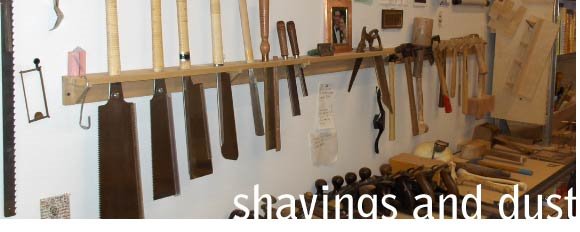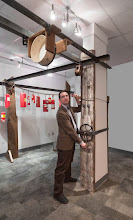This does mean, thought that I was not in the studio for three days, which began to weigh on me by Sunday, yesterday. I got so twitchy that as Karen was unwrapping gifts, I was cutting the wrapping paper into squares and folding cranes out of it, just so that I had something to do. Though there are some who enjoy the craft of creating events, and there are many who enjoy experiencing them, I get more joy from making things, and my hands eventually decided that if I wasn’t going to use them to make anything, they would make something themselves.
This is not meant to indicate that I am not grateful for all of the work that everyone put into the weekend. It was astounding and lovely. But it was also good to get back into the studio today and to make a little sawdust.
My sister and her fiancé have trained their lovely hound Harriet that there is an invisible fence buried in their yard. She is getting pretty good about knowing where it is and about playing in the yard unchaperoned. Across their front walk they have strung an old dog leash, and she knows now that when it is there, the fence is on, but that when it is not she can pass through. Smart dog.
We were sitting at dinner and my sister was telling us about this and she asked if I had any ideas about a gate that they could use that would look better than an old leash strung across the front walk. Boy, did I?!? Put me directly in mind of Walter Rose, of course: “I would fain doff my hat before such a gate, for it speaks of the craftsman, a carpenter whose work is the expression of his life…” Gate building was, at one time, a very specific task, done in the way that carpenters had done it for hundreds of years, each component of the gate designed by generations of experience in a way that a pressed steel gate, such as you may see today, is not.
I began to think and to scheme about making a gate. Not a full on gate, not a huge farm gate, but a little ornamental piece that would be a symbol of a gate as well as an indicator to Harriet that the fence was on. I determined to use hand tools as much as possible, and to not get over-fussy with it, because as Rose says, “the carpentry of the countryside ought not to savor too much of the jointer’s bench.”
What a pleasant way to return to the workbench after a three day hiatus. I had made sure when I left that all of the planes and chisels were mirror-polished and sharper than razors, and walked in to a swept studio and an empty bench pregnant with possibilities. I had some Douglas Fir left from other projects, and laid into it. Fir gives such beautiful long curling shavings when planed by hand, and the smell that it lets off is intoxicating. I cut the joints and went over to the hardware cabinet to choose the nails. I still have a lot of the nails that I made a couple of years ago, and thought it would be fun and fitting to use clinch nails to hold the gate together.
Clinching nails is a practice that is for the most part gone, but it once was standard practice for a lot of applications. Doors, for example. Dickens begins A Christmas Carol by telling us that “Marley was as dead as a door-nail,” and goes on to remark in passing that he does not know what in particular is so dead about a door-nail. Well, anyone familiar with carpentry certainly does. Exterior doors (and gates) were often nailed together up until the last century, and because the nails were hand-forged and untempered, they were soft. So a hole was drilled, the nail was hammered home, and then “clinched” or bent over on the back side. So installed, it would never come out again, and so was “dead.” Doors made in this way have lasted hundreds of years in some cases, far out-living modern hollow-core doors that you buy at big box stores.
Of course clinching nails is now an exercise in nostalgia. But then, as Garrison Keillor says, nostalgia is my sin. And it is appropriate to clinch-nail a gate together. And I had all of these nails anyway, so it seemed like a good choice. And it is fun, so there.
So I made up the gate and the posts, and a little latch on the other side with a counterweight made of a big chunk of steel that I had around the shop. The hinge is one that I made as an experiment a couple of years ago, and is not terribly good as hinges go, but entirely serviceable. Better that it be used than sit in a drawer until it gets thrown out, after all.
Lugged all of this up to Sharon, Mass, where they live and went to hammer it into the ground. The rocky ground. Very rocky ground. There is always something, and this time the something was that. Rather than pound them 12” – 18” into the dirt, I was only able to get them to go in about 9”. Which is not far enough in my book, and makes the gate too high besides. So I am going to have to revisit this, maybe with a pick-mattock.
For now, though, the gate is there, with a little ornamental jowl cut in like on the gates that Rose shows in his book. A great project to get my hands working again, though, and it is always a joy to make something for people I love.
Here is a photo of the gate:

And a photo of the hinge which is also clinch nailed on:

Here is the other end and the counter-weighted latch. There is, I am sure, a better design, but this is what I came up with, and it works well enough:

This nice little project was the penultimate piece that will be made in the studio. The next (and last) piece will be a birdbath for our new house in Syracuse, after which I will start the bittersweet project of packing the studio to move.


No comments:
Post a Comment